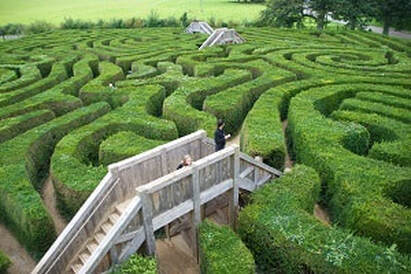Amaze, Amazing
 Does a maze confound or amaze you? Is a maze a source of wonder or confusion? The words amaze and maze are related in Old English but before that the sources of the words are uncertain.
Does a maze confound or amaze you? Is a maze a source of wonder or confusion? The words amaze and maze are related in Old English but before that the sources of the words are uncertain.The word amaze comes from the Old English words amasod (amazed) and amasian (to confound, to confuse) from the Old English root maes. The Old English prefix a- added to maes when forming amasod and amasian suggests an intensity of amazement or confoundment or confusion. Old English maes may come from Norwegian mas (exhausting labour) or Swedish masa (to be slow or sluggish).
The verb ‘to amaze’ (to overwhelm or confound with sudden surprise or wonder) comes to English in the 1580s from Old English amasod and from the late 14th century word amased (stunned, dazed, bewildered). Earlier, in the 13th century, amased meant stupefied, irrational, foolish.
The adjective amazing, from the early 15th century, described something that stupefied or dumbfounded you. The noun amazement (mental stupefaction or the state of being astonished) is from the 1590s. By the 1590s, amazing also meant something dreadful.
However, by 1600 mazement meaning ‘overwhelming wonder’. By 1704, the word amazing also meant wonderful. What happened? The words amaze and amazement take an almost 1800 turn in meaning from around 1600—from stupefaction and dreadful to astonishment and wonder.
What might have prompted this relatively sudden change in what the word meant for people?
The word maze is also from Old English maes. Around the beginning of the 14th century, if something seemed delusional, bewildering, or a confusion of thought, it was called a maze. By the late 14th century, the word maze also meant a baffling network of paths or passages.
Maze or labyrinth? A maze has multiple entries, exits, paths, and dead ends. A labyrinth is like a maze except there is only one way in and one way out.
Reference: Online Etymological Dictionary, https://www.etymonline.com/
Published on February 20, 2021 12:44
No comments have been added yet.



